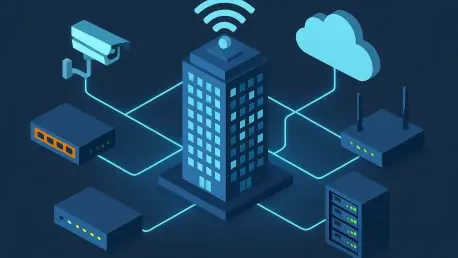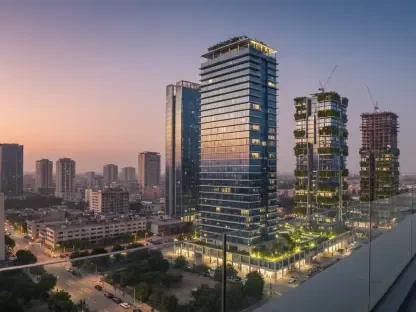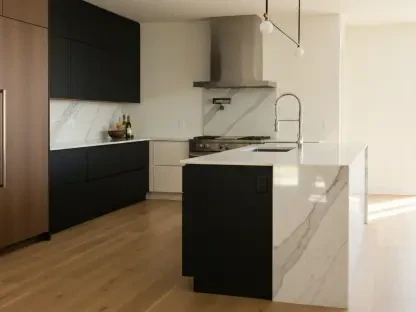In an era where technology shapes nearly every aspect of daily life, the real estate industry is undergoing a profound shift, with smart buildings emerging as the new standard for value and functionality, moving beyond traditional metrics like location or architectural design. Properties—from high-end residential complexes to state-of-the-art office towers—are now evaluated based on their digital capabilities. Tenants and businesses demand seamless connectivity, automated systems, and efficient digital services as essential components of their living and working environments. At the core of this transformation is smarter network infrastructure, a critical enabler that supports the complex demands of modern properties. This article explores the pivotal role of advanced networking solutions, particularly how they elevate building performance, tenant satisfaction, and sustainability, while redefining competitive advantage in a tech-driven market. By delving into the challenges of outdated systems and the promise of innovative technologies, a clear picture emerges of how digital infrastructure is reshaping the future of real estate.
Rising Digital Demands in Property Markets
The landscape of real estate has evolved dramatically, with digital amenities becoming as vital as traditional features like parking or proximity to transit hubs. Tenants now expect high-speed internet, smart automation for lighting and climate control, and integrated platforms that streamline daily tasks, whether in a luxury apartment or a corporate office. Buildings that meet these expectations not only attract occupants more quickly but also retain them for longer periods, often commanding higher rental rates. This trend reflects a broader societal shift toward technology dependence, where connectivity is no longer a luxury but a baseline requirement. Property owners and facility managers face increasing pressure to invest in robust network infrastructure to keep pace with these demands, ensuring their buildings remain relevant in a market where digital prowess can make or break a deal. Without such capabilities, even well-located properties risk falling behind as competitors leverage technology to offer superior experiences.
Moreover, the implications of this digital shift extend beyond tenant satisfaction to influence broader business strategies. Buildings equipped with advanced connectivity can support a range of applications, from remote work setups to smart security systems, which are now critical for both residential and commercial spaces. This creates a ripple effect, as properties that prioritize digital infrastructure often see improved operational efficiency and reduced vacancy rates. The ability to offer reliable, high-speed connections and tech-enabled amenities positions a building as a forward-thinking asset, appealing to tech-savvy tenants and businesses alike. For property managers, this means rethinking traditional approaches to building design and maintenance, placing network infrastructure at the forefront of planning and investment decisions. As the market continues to prioritize digital integration, ignoring these expectations could result in diminished property value and lost opportunities in an increasingly competitive field.
Challenges of Outdated Network Systems
Traditional copper-based Local Area Networks (LANs), once the backbone of building connectivity, are proving woefully inadequate in the face of modern technological demands. Designed for a time when digital needs were far simpler, these systems struggle to support the bandwidth-intensive applications that define today’s smart buildings, such as the Internet of Things (IoT), Wi-Fi 7, and centralized security platforms. The limitations are stark—copper networks require signal boosters and dedicated telecommunications closets every 100 meters, consuming valuable space that could be repurposed for revenue-generating uses. This cumbersome setup not only complicates network architecture but also increases maintenance costs, creating inefficiencies that hinder a building’s ability to adapt to evolving digital requirements. As a result, these outdated systems are a significant barrier to achieving the seamless connectivity that tenants now expect as standard.
Compounding the issue, copper-based infrastructure lacks the scalability needed to keep up with rapid advancements in technology. As more devices connect to building networks—from smart thermostats to high-definition surveillance cameras—the strain on these legacy systems becomes evident through slower speeds and frequent disruptions. This can directly impact tenant satisfaction, as unreliable connectivity disrupts both personal and professional activities, potentially leading to higher turnover rates. Furthermore, the physical constraints of copper networks make upgrades costly and disruptive, often requiring extensive rewiring or structural changes to accommodate new demands. For property owners, this creates a dilemmcontinue to patch an aging system at great expense or face the risk of obsolescence. The clear takeaway is that clinging to traditional LANs is no longer a viable option for buildings aiming to remain competitive in a market driven by digital innovation.
Revolutionizing Connectivity with Optical LAN
Optical LAN, a cutting-edge networking solution built on fiber-optic technology, is emerging as the answer to the connectivity challenges faced by modern buildings. Unlike copper systems, this approach simplifies network design by utilizing a centralized optical switch connected via single-mode fiber optic cable to distributed modems throughout a property. The advantages are transformative, offering blazing speeds ranging from 10G to potentially 100G in future iterations, with upgrades achievable by adding new wavelengths rather than replacing entire cable systems. Optical LAN also provides remarkable flexibility, allowing building operators to allocate bandwidth dynamically—offering 1G for basic needs and 10G for high-density areas like coworking spaces or digital displays. Perhaps most impressively, fiber can transmit data up to 20 kilometers without signal degradation, eliminating the need for intermediate hardware and freeing up space for other uses.
In addition to its technical superiority, Optical LAN enhances building functionality in ways that directly benefit both owners and tenants. The extended reach and reduced need for equipment mean fewer disruptions during installation or maintenance, a significant advantage in occupied or historically sensitive properties where space and access are limited. This technology also supports a wide array of applications critical to smart buildings, from IoT-enabled devices to high-bandwidth services, ensuring that connectivity remains robust even as demands grow. For facility managers, the streamlined architecture translates to easier oversight, as network performance can be monitored and adjusted centrally without invasive interventions. As buildings increasingly rely on digital systems for everything from energy management to tenant communications, Optical LAN provides a reliable foundation that not only meets current needs but also anticipates future innovations, securing a property’s long-term value.
Driving Sustainability and Cost Savings
One of the standout benefits of Optical LAN is its profound impact on energy efficiency, a critical consideration in the push for sustainable building practices. Compared to copper or wireless alternatives, this technology consumes up to 40% less power, with some implementations proving eight times more efficient in energy use. This reduction directly lowers cooling requirements and operational costs, contributing to a smaller carbon footprint that aligns with environmental goals and green certifications like BREEAM. In fact, certain assessments have demonstrated a 7.7% improvement in BREEAM scores following Optical LAN deployment, highlighting its role in achieving sustainability targets. With a lifespan exceeding 50 years when paired with single-mode fiber cabling, this infrastructure represents a long-term investment that minimizes the need for frequent replacements, further reducing waste and environmental impact over time.
Financially, the adoption of Optical LAN offers compelling advantages that extend beyond energy savings to overall operational simplicity. The centralized nature of the system means that updates and maintenance can be managed with minimal disruption, avoiding the costly downtime associated with traditional network overhauls. This is particularly valuable in older or heritage buildings, where installing new infrastructure often poses logistical challenges; Optical LAN can often utilize existing conduits, slashing installation costs. By reducing the physical footprint of network equipment, properties gain additional space for rentable areas or amenities, enhancing revenue potential. These combined savings—on energy, maintenance, and space—make a strong case for transitioning to fiber-based solutions, positioning buildings not just as sustainable but also as economically savvy choices in a market increasingly focused on efficiency and cost-effectiveness.
Enhancing Market Position Through Tenant-Centric Innovation
In a real estate market where differentiation is key, smarter network infrastructure like Optical LAN serves as a powerful tool to elevate tenant experience and building appeal. Reliable, high-speed connectivity underpins a range of modern amenities, from IoT-driven conveniences like smart thermostats to robust digital services that streamline communication and access. Tenants benefit from uninterrupted access to these features, which in turn boosts satisfaction and encourages longer lease commitments. Buildings that prioritize such capabilities stand out as premium offerings, attracting discerning occupants who value technology as much as physical space. This focus on digital excellence transforms a property into a desirable asset, capable of commanding higher rents and maintaining low vacancy rates even in competitive markets.
Security, another critical tenant concern, is also significantly enhanced by Optical LAN’s inherent advantages over traditional systems. Fiber technology offers built-in encryption and device authentication, alongside resistance to electromagnetic interference, making it ideal for sensitive applications like access control and video surveillance. This added layer of protection reassures occupants, particularly in commercial settings where data integrity is paramount. For property owners, the ability to market a building as both technologically advanced and secure provides a distinct edge, appealing to businesses and residents alike who prioritize safety alongside connectivity. As the real estate sector continues to evolve, integrating such infrastructure becomes not just a response to current trends but a strategic move to future-proof properties against shifting tenant expectations and technological advancements.
Building a Foundation for Tomorrow’s Real Estate
Reflecting on the evolution of smart buildings, it’s evident that advanced network infrastructure has played a pivotal role in redefining property standards over recent years. Optical LAN, with its unmatched speed, scalability, and efficiency, addresses the glaring shortcomings of outdated copper systems, enabling properties to support cutting-edge technologies and tenant needs. Its contributions to sustainability through reduced energy consumption and alignment with certifications like BREEAM set a benchmark for environmentally conscious development. Looking ahead, property owners and managers are encouraged to view such technology as a strategic asset, essential for staying competitive. Investing in scalable solutions now ensures readiness for future innovations, while fostering tenant loyalty through superior digital experiences. By prioritizing smarter networks, the real estate industry can continue to build spaces that are not only functional and sustainable but also poised to lead in a digitally integrated world.









